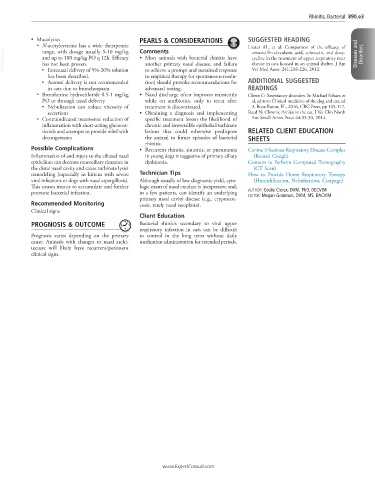Page 1773 - Cote clinical veterinary advisor dogs and cats 4th
P. 1773
Rhinitis, Bacterial 890.e3
• Mucolytics PEARLS & CONSIDERATIONS SUGGESTED READING
○ N-acetylcysteine has a wide therapeutic Comments Litster AL, et al: Comparison of the efficacy of
VetBooks.ir and up to 100 mg/kg PO q 12h. Efficacy • Most animals with bacterial rhinitis have amoxicillin-clavulanic acid, cefovecin, and doxy- Diseases and Disorders
range, with dosage usually 5-10 mg/kg
cycline in the treatment of upper respiratory tract
disease in cats housed in an animal shelter. J Am
another primary nasal disease, and failure
has not been proven.
Intranasal delivery of 5%-20% solution
■
to empirical therapy (or spontaneous resolu-
has been described. to achieve a prompt and sustained response Vet Med Assoc 241:218-226, 2012.
Aerosol delivery is not recommended tion) should provoke recommendations for ADDITIONAL SUGGESTED
■
in cats due to bronchospasm advanced testing. READINGS
○ Bromhexine hydrochloride 0.5-1 mg/kg • Nasal discharge often improves transiently Clercx C: Respiratory disorders. In Michael Schaer, et
PO or through nasal delivery while on antibiotics, only to recur after al, editors: Clinical medicine of the dog and cat, ed
Nebulization can reduce viscosity of treatment is discontinued. 3, Boca Raton, FL, 2016, CRC Press, pp 105-117.
■
secretions • Obtaining a diagnosis and implementing Reed N: Chronic rhinitis in the cat. J Vet Clin North
○ Contraindicated treatments: reduction of specific treatment lessen the likelihood of Am Small Anim Pract 44:33-50, 2014.
inflammation with short-acting glucocor- chronic and irreversible epithelial/turbinate
ticoids and attempts to provide relief with lesions that could otherwise predispose RELATED CLIENT EDUCATION
decongestants the animal to future episodes of bacterial SHEETS
rhinitis.
Possible Complications • Recurrent rhinitis, sinusitis, or pneumonia Canine Infectious Respiratory Disease Complex
Inflammation of and injury to the ciliated nasal in young dogs is suggestive of primary ciliary (Kennel Cough)
epithelium can decrease mucociliary clearance in dyskinesia. Consent to Perform Computed Tomography
the distal nasal cavity and cause turbinate lysis/ (CT Scan)
remodeling (especially in kittens with severe Technician Tips How to Provide Home Respiratory Therapy
viral infections or dogs with nasal aspergillosis). Although usually of low diagnostic yield, cyto- (Humidification, Nebulization, Coupage)
This causes mucus to accumulate and further logic exam of nasal exudate is inexpensive and,
promote bacterial infection. in a few patients, can identify an underlying AUTHOR: Cécile Clercx, DVM, PhD, DECVIM
EDITOR: Megan Grobman, DVM, MS, DACVIM
primary nasal cavity disease (e.g., cryptococ-
Recommended Monitoring cosis, rarely nasal neoplasia).
Clinical signs
Client Education
PROGNOSIS & OUTCOME Bacterial rhinitis secondary to viral upper
respiratory infection in cats can be difficult
Prognosis varies depending on the primary to control in the long term without daily
cause. Animals with changes to nasal archi- medication administration for extended periods.
tecture will likely have recurrent/persistent
clinical signs.
www.ExpertConsult.com

